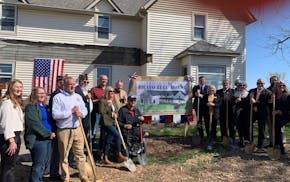A highly anticipated environmental report on the proposed Southwest light-rail line, released Friday, concluded that the project would change the character of a portion of Minneapolis' Chain of Lakes — but that steps would be taken to dampen the impact.
The 17,000-page final environmental impact statement of the line, published by the Federal Transit Administration, represents one of the last regulatory hurdles before the project can proceed toward construction. A federal lawsuit continues to loom over the project, however, and it remains unclear whether the state will commit the $135 million needed to secure half of the $1.7 billion cost from the federal government.
The 14.5-mile Southwest line, an extension of the Green Line, would run from downtown Minneapolis to Eden Prairie.
The release of the report, which outlines impacts and how to minimize their effects, comes as project supporters press hard for the Legislature to approve funding before this session ends on May 23.
The review found that running light rail with freight rail on new concrete bridges between Lake of the Isles and Cedar Lake would create additional noise and a "tunnellike space" for boaters moving through the channel. Planners intend to reduce the effect by building a short wall and installing noise-reducing rail components along the bridge.
Squeezing recreational trails, light rail and freight trains through that corridor has been one of the most controversial aspects of the project. The review did not find major problems associated with another core facet of that plan, a shallow tunnel south of the lake connection, except for vibration noise that would be alleviated with special fasteners.
"The project has conducted in-depth, independent studies on potential impacts to the lakes," said spokeswoman Laura Baenen. "These studies show that the project will not negatively impact water levels or quality of the lakes."
The environmental review has played a key role in the lawsuit by the Lakes and Parks Alliance of Minneapolis, which claims that the Metropolitan Council prematurely locked into a specific route for the line before fully analyzing all of the environmental impacts. Other routes would have relocated the freight rail, easing congestion on the corridor.
The public has until June 13 to comment on the environmental review, before it receives final signoff from the Met Council and the federal government. That clears the way for construction to begin, though funding and legal hurdles may not be resolved.
A draft review of the line's impacts, released in May 2015, made a preliminary finding that it would have adverse effects on the Kenilworth Lagoon and the greater Grand Rounds Historic District. That was finalized in Friday's update.
Specifically, the plan would require replacing an existing wooden bridge with three concrete bridges covering a wider span. The review found that the new bridge arrangement would reduce light and add noise in the area.
"The increased noise levels generated by LRT operation, combined with the introduction of a tunnellike space will diminish the integrity of setting and feeling by altering the user experience, resulting in an adverse effect," the review said.
In addition, the Met Council would repair and rebuild WPA-era retaining walls in the area.
Across the line, the study found that noise walls, rail "quiet zones" and bells at crossings would be necessary to avoid severe noise impacts on several hundred residential properties — primarily from light-rail vehicle horns.
The project also was revised to relocate a noise wall and a signal facility in order to reduce visual impacts surrounding the Chicago, Milwaukee, St. Paul & Pacific Railroad Depot in St. Louis Park.
The report tallied the $29 million cost of add-ons such as new trails and roads, requested by suburban locales. Those jurisdictions are responsible for those costs.
Ongoing lawsuit
There's been no resolution to the lawsuit yet.
U.S. District Judge John Tunheim wrote in an order last August that the municipal consent process and the Met Council's assembling support for one route "certainly comes close to having the practical effect of limiting the available options, such that the remaining federal environmental review is meaningless."
He added that the final stages of city approval and environmental review could "provide that searching analysis" to inform policymakers and the public.
The Lakes and Parks Alliance won an initial attempt in January to obtain behind-the-scenes Met Council communications to bolster its argument, but it is now waiting for a ruling on the Met Council's appeal of that matter.
Mary Pattock, Lakes and Parks Alliance spokeswoman, said the documents released Friday bolster their case.
"It confirms our basic complaint, which was that the Met Council never has given a good full-faith consideration to alternative, less environmentally damaging routes," Pattock said.
She added: "[The impact statement] admits for the first time and unequivocally that the route will damage the Chain of Lakes. And that is why we filed the lawsuit in the first place."
Eric Roper • 612-673-1732
Twitter: @StribRoper

Defense attorneys in Feeding Our Future trial cast doubt on FBI's massive meal fraud investigation

Overdose deaths spike after incarceration, but Minnesota jails lack treatment

New sober house for veterans in southern Minnesota wants to treat the real issue: PTSD
Two North Loop condos combined into one 'dreamy' space listed for $649,900

